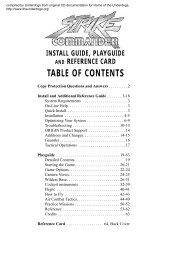mega.txt MEGAFORTRESS MANUAL These are the IFF codes that ...
mega.txt MEGAFORTRESS MANUAL These are the IFF codes that ...
mega.txt MEGAFORTRESS MANUAL These are the IFF codes that ...
Create successful ePaper yourself
Turn your PDF publications into a flip-book with our unique Google optimized e-Paper software.
source of ram air for cooling and ventilation <strong>the</strong> crew<br />
compartment.<br />
1) At altitudes above 9,000 feet, cabin pressure<br />
switch must be turned to standard 7.45 PSI, or to 4.50<br />
PSI combat setting if severe changes in altitude <strong>are</strong><br />
expected during rapid maneuvering.<br />
2) If <strong>the</strong> cabin pressure system is damaged or turned<br />
off at altitudes above 9,000 feet, complaints from <strong>the</strong><br />
crew <strong>are</strong> broadcast on <strong>the</strong> interphone.<br />
3) Emergency cooling and ventilation can be<br />
provided by turning CABIN PRESSURE switch to<br />
RAM.<br />
INTERPHONE<br />
Interphone messages <strong>are</strong> broadcast via <strong>the</strong> Interphone<br />
panel at each station, and along <strong>the</strong> bottom edge of<br />
<strong>the</strong> display. Messages from <strong>the</strong> AFSACOM system<br />
(please see "MF Briefing,"), <strong>the</strong> command<br />
radio and liaison radio systems, and crew members,<br />
<strong>are</strong> routed through <strong>the</strong> interphone to every station in<br />
<strong>the</strong> message display line. A flashing light in <strong>the</strong><br />
Interphone Panel (please see "Multi-station<br />
Instruments,") indicates <strong>that</strong> its corresponding<br />
station requires attention.<br />
1) The interphone switch must be ON for <strong>the</strong><br />
message traffic to be routed to <strong>the</strong> Interphone panel,<br />
or to <strong>the</strong> bottom of <strong>the</strong> display.<br />
TRANSPONDER<br />
The AN/APX-64 <strong>IFF</strong> transponder is <strong>the</strong> airborne<br />
portion of a two-way link between <strong>the</strong> aircraft and<br />
ground radar installations. The ground radar station<br />
sends an interrogation signal which is received by <strong>the</strong><br />
aircraft; <strong>the</strong> aircraft transponder (reply system) replies<br />
with coded signals <strong>that</strong> <strong>are</strong> received on <strong>the</strong> ground<br />
and displayed on <strong>the</strong> radar scope as unique<br />
identification and altitude signals. In addition <strong>the</strong><br />
transponder contains provisions for transmission of<br />
an "identification of position" (IDENT) signal.<br />
WARNING<br />
Failure to identify <strong>the</strong> aircraft correctly when<br />
contacted by air traffic controllers will result in <strong>the</strong><br />
destruction of <strong>the</strong> aircraft by friendly fire.<br />
In <strong>the</strong> vicinity of <strong>the</strong> first waypoint or any o<strong>the</strong>r<br />
friendly radar site, <strong>the</strong> aircraft may be contacted by<br />
friendly ATC and identification requested.<br />
1) Switch <strong>the</strong> Transponder switch to STBY.<br />
2) The first two digits on <strong>the</strong> transponder <strong>are</strong><br />
automatically adjusted to match <strong>the</strong> 2-digit code<br />
15
















